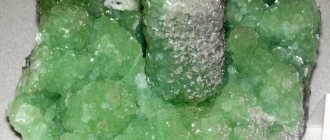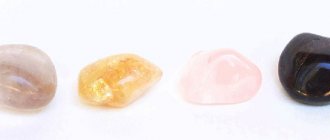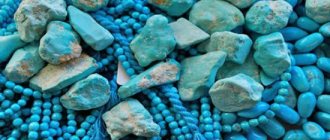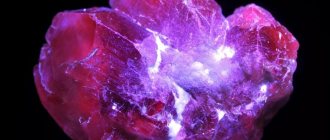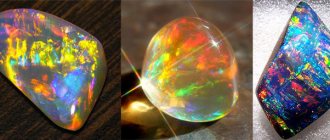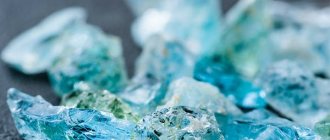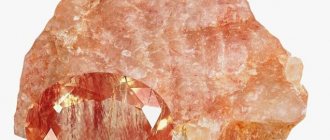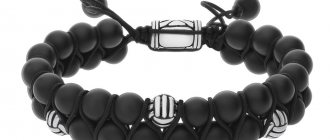Selenite stone, named after the lunar goddess Selene, who was worshiped by the ancient Greeks, is the personification of femininity and sophistication and is considered a feminine mineral. It is characterized not only by the beauty and mystery associated with the goddess of the Moon, not only by magical and healing qualities, but also by the purely practical characteristics of a soft ornamental stone, from which jewelry, souvenirs, amulets and various figurines of animals, fish and birds are made. Although moonstone is very fragile, it is used to make containers for incense and medicine, where they retain their aromas and healing properties much longer than in other packages.
Story. Origin
Until the beginning of the 19th century, this mineral was known under the names:
- oriental alabaster;
- Egyptian stone;
- Ural stone.
In 1817, the chemist Berzelius named it selenite in honor of the Greek moon goddess Selene.
Selenite, with its unusual radiance and iridescent brilliance, resembles a moonstone (adularia), but calling it that is inappropriate, since this is the gemological name for adularia.
The amazing property of the mineral to glow from within was the reason that in ancient times this feature was perceived as magic and this stone was used in magical rituals. Archaeologists have found many ritual attributes made from selenite.
They made dishes, figurines, and decorations from it. In the Middle Ages, it began to be used to make church utensils, and selenite figurines decorated the houses of the nobility.
In the 19th century, selenite became popular in Russia. Its snow-white samples were found in the Perm province and used in the decoration of the Winter Palace. Ural craftsmen began to make jewelry and figurines from it. Such products decorated many homes. Selenite elephants were especially popular; they were believed to bring happiness to the home.
The origin of this translucent mineral is associated with the fossilization of sedimentary materials. It is formed in sand and clay rocks in the form of veins and fibers.
Selenite deposits
Selenite is a common stone.
The formation of this mineral occurs during the transformation of sea water. In essence, it is a chemical sediment that forms when marine areas dry out. It is mined in an open way: first, a layer of clay is removed, then sedimentary rocks are removed, and selenite layers are located under them. — Advertising —
The main deposits of selenite are located on the territory of Russia (the coastal slopes of the Iren River). In Europe, mineral deposits are also developed industrially in many countries. The supplier of high quality samples is Sri Lanka.
Physicochemical characteristics
Selenite is a morphological variety of gypsum. The structure of its units is parallel-fibrous. Thanks to this, a beautiful optical iridescence effect appears on the polished surface of selenite. If the pebble is turned from side to side, a moving stripe of color will be visible (cat's eye effect).
The color of pure varieties is white, but more often the stone has pastel shades (pink, yellow, beige, blue).
From a chemist's point of view, it is aqueous calcium sulfate.
- Chemical formula - CaSO42H2O .
- Color - white, gray, sometimes green, orange.
- The shine is silky, pearlescent.
- Transparency - transparent and translucent.
- Hardness - 1,5–2.
- Density - 2.31–2.33 g / cm3 .
This beautiful soft mineral can be easily polished, which is why it is a popular ornamental stone.
The term "selenite" is used in English-language sources to designate all transparent aggregates and crystals of gypsum, as opposed to the opaque massive varieties of the mineral.
Color varieties
The most common white crystals in nature are selenite. The combination of color and unusual glow, in fact, gave rise to its second name “moonstone”.
There are also rarer, but no less beautiful specimens of pink, blue, light yellow, gray and pale green shades. The rarest specimen is considered to be black selenite - labradorite. If you look closely at this stone, you can contemplate the mystery of a dark moonlit night.
Application
Selenite is widely used as an inexpensive ornamental stone. Figurines, figurines, candlesticks, boxes, amulets, amulets, and talismans are made from it.
It is also used in jewelry. It is used to make beads, inserts into earrings, bracelets and pendants.
The mineral is also used:
- in the production of astringents in the chemical industry and medicine;
- for the manufacture of paints;
- for the production of foundry molds in mechanical engineering.
Fake or real
Selenite is considered an ornamental stone. There are many deposits of it in nature, so it has a low cost. It would seem that there is no need to create artificial copies. However, you can still find imitation minerals on sale.
A synthetic fake is a silicate semi-liquid mass with impurities that are interspersed longitudinally to achieve the desired effect. Then this mass is turned into an artificial crystal, and after grinding and processing the finished product comes out. You can still distinguish such a product from the original:
- Firstly, the cost is very low - if a natural stone is affordable, then a fake will cost a penny.
- Secondly, strength. The natural mineral is very soft, fragile, and is easily scratched by a fingernail, which cannot be said about its synthetic counterpart.
- Thirdly, the size of the product. Of course, when it comes to jewelry, this criterion is not taken into account. But if these are crafts or figurines, then their size cannot exceed 30 cm - due to its fragility, it is simply impossible to make large products from selenite.
It is worth paying attention to the fact that any dubious counter does not guarantee quality. For beautiful, natural products, it is better to go to a jewelry store, where you can get complete information about any product.
Medicinal properties
Selenite has long been used to improve physical and mental health:
- Ancient Greek healers called it the Apollo crystal, because they believed that selenite was able to give its owner strength and good health.
- The healing properties of selenite were recognized by Avicenna. His works mention that the mineral was used to treat diseases associated with weakness of body and spirit (for example, epilepsy).
- The stone was used to treat fractures, wounds, and swelling.
- In ancient Egypt, it was used as a means to promote skin elasticity.
- Tibetan healers used selenite to remove stones from the gallbladder.
Lithotherapists note the benefits of the mineral in the treatment of the following diseases:
- hypertension;
- diseases of the endocrine system;
- myopia;
- infertility;
- diseases of the gastrointestinal tract;
- diseases of the liver and spleen.
If you decide to use a mineral for healing, do not neglect the treatment prescribed by your doctor.
Specialists in lithotherapy recognize other healing abilities of selenite:
- Relieves mental and emotional stress, protecting against depression.
- Helps get rid of headaches.
- Reduces inflammation, lowers temperature.
- Stimulates joint mobility and maintains ligament elasticity.
- Strengthens teeth and bones.
Selenite is of particular importance for a person prone to depression and hyperactivity, as it has a positive effect on the emotional and mental state of its owner.
Types of Selenite
For selenite, many different subspecies are known, which also often receive their own names and are therefore known as independent minerals. When classifying, both the appearance and the deposits of the subspecies are taken into account. For example, samples that are mined in the White Sea are called “white-morites,” and black selenites are known as “labradorites.”
Magic properties
Selenite has magical powers, so it is very useful to use it in magical rituals - this is what they believed in the old days.
Yogis still use the mineral in telepathic sessions, as they believe that it cleanses the mind.
In addition, according to Hindus, selenite is of particular importance for a person who wants to develop memory, the gift of eloquence and persuasion. It is believed that the energy of the iridescent stone, similar in its brilliance to the moonlight, is associated with the Moon. During the new moon, the magical properties of selenite increase, and the radiance of the stone also intensifies.
This gem symbolizes the magical power of the Moon, therefore it is considered the most suitable amulet for people born on a full moon, and for those born on Monday - the day “ruled” by this celestial body.
The uniqueness of the magic of selenite is manifested in the fact that the gem enhances the qualities most characteristic of both sexes:
- It gives women beauty, tenderness, femininity, gentleness of character, develops emotionality, and dreaminess.
- Men become more strong-willed, brave, and their fortitude increases.
It is very important to establish a physical connection with this stone, shimmering with a mysterious shine, and then it will help in many ways:
- Protects against dark energy.
- Gives you the ability to predict the future.
- Will bring good luck.
- It will give you prudence and help you make the right decisions in difficult situations.
- Will protect you from troubles and rash actions.
- Strengthens memory.
- Will develop imagination (especially if the gem is framed in silver).
- Will help you overcome obstacles on the path to happiness.
A figurine made of this stone will bring peace to the house, harmony in relationships between household members, and will help strengthen or revive the tenderness of feelings. Selenite is a very powerful amulet of the family hearth and family relationships.
Favorable time to buy
Any time can be favorable, especially if you have firmly decided to buy this particular gem.
According to astrologer Olga Potemkina, it is recommended to avoid buying things that you will wear on yourself, including jewelry and watches, on full moon days.
They fall on the 15th and 16th lunar days. Things bought on the 28th lunar day will delight you for a long time. She considers the 30th lunar day the most suitable for purchasing art, jewelry and metal objects. It must be taken into account that the lunar day is shorter than the calendar day, and the number of the lunar day does not coincide with the date on the calendar.
Who is suitable according to their zodiac sign?
Most astrologers believe that selenite is friendly to all signs of the zodiac, but some do not recommend wearing it to Virgo . According to the horoscope, the following are ideal for this zodiac sign: carnelian, agate, yellow sapphire, jasper, citrine, tiger's eye, labradorite, carnelian, serpentine, pegmatite (written granite), black diamond, anhydrite (angelite), howlite, chrysoberyl, scapolite.
Selenite has a particularly good effect on Cancer, Scorpio, Pisces . He will fully reveal his magical properties to them, help them overcome obstacles on the path to happiness, and will contribute to success in all their endeavors. Pisces will become bolder and gain confidence in their abilities.
Selenite will also be a lucky stone for Gemini, Aquarius, Leo .
He has a neutral-positive attitude towards the other signs of the zodiac.
Talismans and amulets
Selenite box 7.5 cm
Selenite is magically powerful. It can serve as a talisman, a talisman, and an energy accumulator.
Hindus have always considered selenite stone sacred. Only priests were allowed to wear it. They placed selenite at the head of the bed at night, and in the morning they uttered a prophecy. Rumors about the amazing accuracy of their predictions have survived to this day, perhaps that is why modern soothsayers and people of other magical specialties strive to get a selenite ball into their collection of magical attributes. Even Yogis use the “moon kiss” when conducting telepathic sessions.
For those who do not want to become clairvoyant, selenite will also be useful:
- For women to become more tender, sophisticated and romantic.
- For men, to become braver and accomplish the main feat.
- For married couples, in order to return the spark to the relationship, to make the house not just a place to live, but a cozy family hearth, where mutual understanding reigns, happiness and love reside.
- For businessmen, it’s like an amulet that programs the consciousness for success and helps the subconscious to anticipate dangers, making the owner lucky and attracting financial flows.
- For phlegmatic people, to show greater interest in life, fill it with bright events and impressions, and get rid of excessive slowness and laziness.
- For people of creativity, to reveal themselves to the fullest and never lose inspiration.
- For bachelors and single ladies to meet love and start a family.
- People who have to work a lot with people, talking about something or persuading them - lecturers, teachers, priests, politicians, announcers, lawyers, in order to develop memory and become more eloquent.
Compatibility with other stones
There are various systems that determine the compatibility of stones with each other. The easiest way to follow is the one in which you can simultaneously wear gems corresponding to the friendly elements: Earth and Water, Air and Fire.
Selenite belongs to the element of Air, it can be combined with “air” and “fire” stones:
- amethyst;
- rock crystal;
- golden beryl;
- topaz;
- sapphire;
- uvarovitis;
- demantoid;
- chrysoprase;
- pomegranate;
- coral;
- sardonyx and others.
Minerals are associated not only with zodiac signs, but also with certain planets. Selenite “submits” to the Moon, it can be worn with stones that are also strongly influenced by it:
- pearls;
- moonstone;
- aquamarine;
- coral;
- beryl;
- rock crystal;
- opal;
- all colorless, blue or white stones.
Coral, rock crystal, and golden beryl are similar to selenite in terms of the influence of both the Moon and the elements on them.
This is interesting!
We bring to your attention some more interesting facts about the stone:
- According to legend, the white speck on selenite waxes and wanes according to the lunar cycle, and on a full moon the stone can cry.
- The most valuable rocks are those extracted on the island of Sri Lanka.
- Experts believe that gem crystals hide information about the future of our planet.
- Selenite is able to purify itself without any help if moonlight falls on it.
How to care
Selenite is a soft, fragile stone, so it must be protected from falls and impacts.
Rules of care:
- Protect from bright sunlight and high humidity.
- It cannot be cleaned with aggressive agents. The stone should be wiped with a soft cloth soaked in soapy water, rinsed with clean water and dried thoroughly.
It is recommended to clean the gem no more than once every six months .
- Store products in individual, soft-lined cases.
- A stone in jewelry can quickly wear out, lose its polish, or get scratched. It needs to be polished and then covered with colorless varnish.
It is recommended to varnish the stone once every 2 years .
To rid selenite of negative energy, do not wash it under running water. It is better to place it under the light of the full moon, then the negative energy will go away and the pebble will be charged with positive force.
Note
Selenite is a stone of pilgrims and is able to absorb the energy of holy places, gaining even greater power. It also serves as a connecting thread between a person and his guardian angel.
To feel this connection, you need to put a stone under your pillow - in a prophetic dream, a hint for further actions will appear from a patron from above. An important aspect is faith - it can greatly increase any magical power, instilling the best feelings in the soul.
4.7/5 — (3 votes)
Price
The cost of jewelry depends on the rarity of the stone and the complexity of the design. The cheapest are white selenites; those with pink and other shades are more expensive.
Examples of prices in Russian online stores:
- pendant - 143 rub. ;
- cabochon (43 x 15 x 4 mm) - 250 rub. ;
- beads (10 mm, 38 pieces) - 779 rub. ;
- sculpture “Scientific Owl” (75 x 60 x 110 mm) - 838 rub. ;
- box - 870 rub. ;
- red selenite, collection sample (10.57 kg) - RUB 21,140.
Selenite colors
Selenite is characterized by a soft white color, similar to fresh milk.
Due to the presence of various impurities in its composition, the mineral acquires shades of pink, blue and yellow. The most valuable varieties of selenite are warm yellow specimens that resemble honey in appearance.
